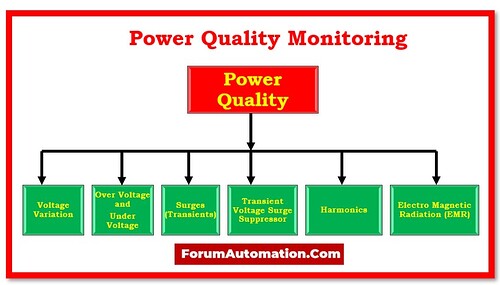Power quality issues relate to a range of electrical abnormalities that can have an influence on the stability, efficiency, & dependability of electrical systems.
These difficulties include voltage fluctuations, harmonics, transient disturbances, electromagnetic interference, and others.
Maintaining beneficial power quality is critical for maintaining the safe and effective functioning of electronic equipment, machinery, & systems in residential, commercial, & industrial settings.
Identifying, assessing, and managing power quality concerns are essential responsibilities for electrical engineers & experts in order to prevent damage to equipment, decrease energy waste, and assure the constant supply of clean and dependable electrical power.
Several reasons lead to power quality issues, including:
1). Voltage Variation
Variation in voltage induced by poorly controlled distribution networks that undergo considerable load variations over time. They are possible when an electrical system shifts to connect to a specific consumer.
2). Overvoltages (swells) and undervoltages (sags)
Overvoltages (swells) & undervoltages (sags) can occur as a result of a sudden load changes or inappropriate transformer tap settings. These may result in shorter equipment life. A swell is a voltage spike of less than 2 seconds duration that occurs outside of the typical tolerances of electronic equipment due to a rapid load drop. A sag is a voltage drop of less than 2 seconds duration that occurs outside of the typical tolerance of equipment due to the start-up of large loads or power system problems.
3). Surges (Transients)
Power line switching, lightning, turning powerful motors on and off, and short circuits all create transients (surges). They can also be caused by basic office equipment like copiers or printers. Because of the ongoing consequences of surges, they may cause slow degradation of device life.
4). TVSS (Transient Voltage Surge Suppressor)
Transient voltages can occur both within and outside of a facility. TVSS devices are intended to reduce transients of any cause.
5). Harmonics
Harmonics are power line frequency (60 Hz) multiples that emerge as result of rectifiers, non-linear loads, & switching power supply.
6). Electromagnetic Radiation (EMR)
Electromagnetic fields (EMFs) are produced by the passage of electrical current flow in conductors & can be observed throughout electrical equipment is plugged in. EMFs can be found in power lines, building wiring, and electrical equipment. Fluorescent bulbs are a significant generator of EMFs.
